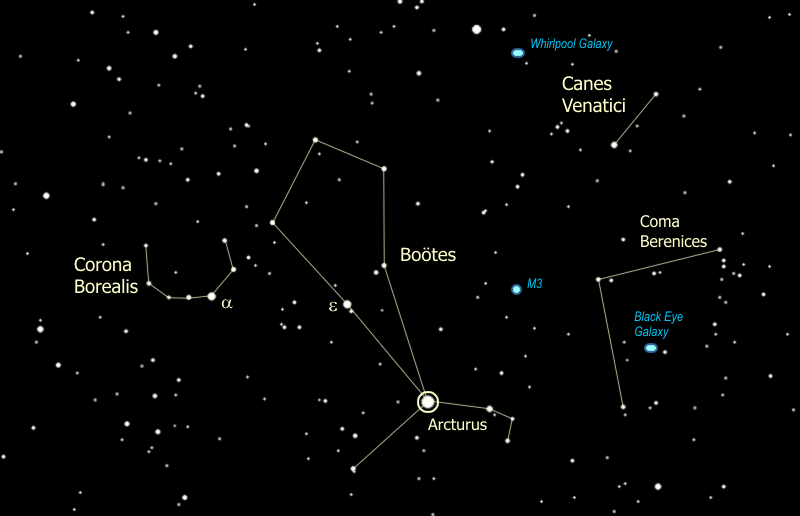Stargazing

|
The Constellation Boötes |

|
- We will now follow the handle of the Dipper and arc to Arcturus, a star
in the constellation Boötes (pronounced boo-OH-teez). {Trace out Boötes}.
Boötes is a herdsman and the Guardian of the Bear -- Ursa Major. It is
usually pictured as a guy just standing there, somtimes with a staff --
you can make the hook of the staff out of the three stars to the north of
the kite, just off the end of the Dipper's handle.

Arcturus is historically famous for a number of reasons. For example it was used to turn on the lights at the 1933 Worlds' Fair in Chicago. They put a telescope on Arcturus, focused the light down to a photocell which then turned on the lights. The reason they did this is that Arcturus is 40 light-years away from us, and the last time the World's Fair had been in Chicago was in 1893, 40 years prior, so the light they were using to start the World's Fair had left the star at the time of the last World's Fair in Chicago. Cool, huh?
Note to the tourguide: when it gets late in the summer and I can no longer effectively use Spica for star brightness & color, I base it on Arcturus starting with the above story, then proceed as follows: They also used Arcturus because it is so bright. What do you think, is Arcturus the brightest star in the sky? Is there any brighter? (The group will find Vega.) Right, that's Vega, and it may look brighter because it's higher in the sky. Technically Arcturus is brighter but they are virtually the same. -- Then go on to point out Altair & Deneb as 1st magnitude stars & Polaris & Dipper as 2nd magnitude examples, then the whole discussion on magnitudes. I then have the group compare Arcturus and Vega for "anything else that's different" to get to star color. By pointing out yellow Dubhe & blue Alkaid and going on to their exclusion from the Ursa Major moving group I get a nice transition back to Corona Borealis.
- Next to Boötes is Corona Borealis, the northern crown. {Trace out Corona Borealis}. The brightest star is α (alpha) Corona Borealis. This star is part of the Ursa Major Moving Group -- the same moving star group as the stars of the Big Dipper!
- To the right of Bootes, just below the handle of the dipper, you can see two
stars. The brighter one is called "Cor Caroli" -- it means the heart of
Charles (King Charles II). These two stars form the constellation Canes
Venatici. If you look carefully you can pick out two faint, scraggly
diagonal lines of stars, one of which includes the two stars I just pointed
out and the other is just a little above it. These two lines are two
dogs on a leash held by Bootes -- come on, use your imagination -- and are
helping him in his duties as herdsman and guardian of the bear.
Cor Caroli is a member of a huge asterism known as "The Diamond of Virgo", which goes from Cor Caroli to Denebola, the easternmost bright star of Leo, to Spica in Virgo, to Arcturus in Boötes, back to Cor Caroli. See it? Isn't it huge?
- Note Boötes is a kite-shaped constellation. It used to be a shorter kite
-- in ancient Greek & Roman times (2,000 years ago) Arcturus was half the
distance closer to the two center stars (epsilon & rho Boötes). It is
moving across the sky faster than any other bright star (except Alpha
Centauri which is ten times closer) -- it couldn't be seen 500,000 years
ago and 500,000 years from now it won't be visible any more. Why is Arcturus
moving so fast?
The stars of our galaxy are formed into a rotating disk and are all moving together around the disk. Some stars -- called "halo" stars -- form a dome over the disk, Arcturus is one of those stars, orbiting above and below the galactic center. It is cutting through the disk now, actually a little bit back against the general flow. Someone on a planet orbiting Arcturus would see the entire night sky changing constantly.
 |
 |
 |
| Back to Polar Constellations | Go to Summer Index | On to Virgo |
Questions
Your questions and comments regarding the Stargazing section are welcome.
You can e-mail the author, Randy Culp for inquiries,
suggestions, new ideas or just to chat.
Updated 18 July 2023
